<< Previous | Displaying results 5701-5750 of 6769 for "" | Next >>
Vidkun Quisling, pro-German Norwegian Fascist leader. Pictured here addressing supporters of his Norwegian Nazi party at a rally. Oslo, Norway, August 1941.
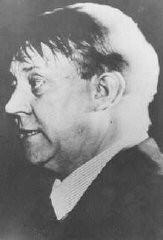
Vidkun Quisling, leader of the collaborationist Norwegian government, returns a salute during a ceremony in Oslo. Norway, after April 1940.
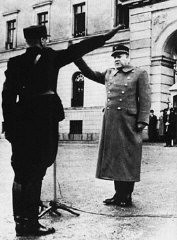
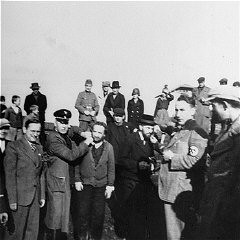
Halina Bryks was photographed in the Kloster Indersdorf children's center in an attempt to help locate surviving relatives. Photographs such as this one showing children holding name cards were published in newspapers to facilitate the reunification of families. Germany, after May 1945.
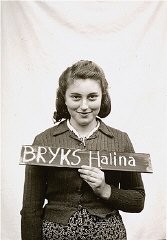
An art class for children in the Fiesole displaced persons camp, outside Florence. Italy, 1946.
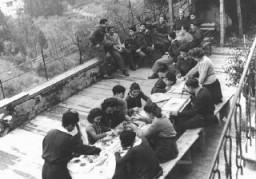
Children learn a religious text from an Orthodox Jewish teacher. Landsberg displaced persons camp, Germany, 1946-1947.
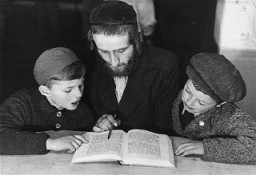
A Hanukkah party for Jewish children at the Fuerth displaced persons camp. Gifts were contributed by families of Americans stationed at the Nuremberg military post. Germany, December 9, 1947.
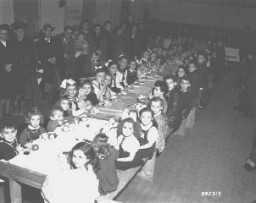
Front page of a newspaper from Landsberg displaced persons camp. Germany, November 15, 1945.
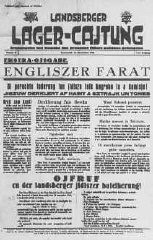
Jewish refugees work on a newspaper at Zeilsheim displaced persons camp. Germany, between 1945 and 1948. The newspaper was titled Unterwegs (The Transient).
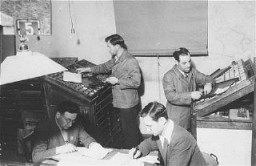
Jewish refugees in front of the "Kibbutz Buchenwald" building, where Jews received agricultural training in preparation for life in Palestine. Buchenwald displaced persons camp, Germany, ca. August 1946.
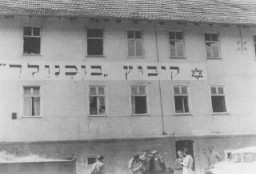
Jewish refugees protest British immigration policy in Palestine. Zeilsheim displaced persons camp, Germany, between 1945 and 1948.
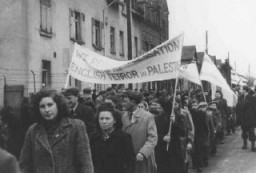
At the Neu Freimann displaced persons camp, a boy displays the tattooed number on his arm to a photographer. Other children look on. Neu Freimann, Munich, Germany, between 1945 and 1949.
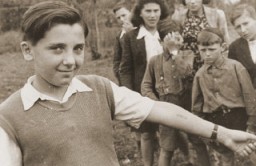
After Adolf Hitler became chancellor of Germany, he persuaded his cabinet to declare a state of emergency and end many individual freedoms. Here, police search a vehicle for arms. Berlin, Germany, February 27, 1933.
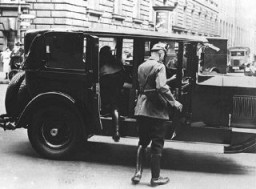
Police search a messenger at the entrance to the building where Vorwaerts, a Social-Democratic Party newspaper, was published. The building was subsequently occupied during the suppression of the political left wing in Germany that was carried out in response to the Reichstag Fire. Berlin, Germany, March 3–4, 1933.
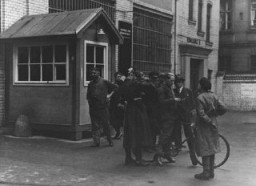
A notice reads "Business closed by the police due to profiteering. Owner in protective custody at Dachau." Signed by police chief Heinrich Himmler. Munich, Germany, April or May 1933.
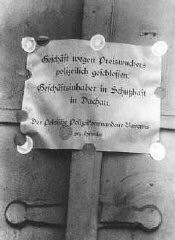
Police search in Berlin. Members of the SA stand nearby. Berlin, Germany, 1933.
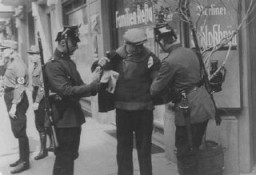
Prisoners at forced labor under SS and police guard in the Oranienburg concentration camp. Oranienburg was one of the first first concentration camps established in Germany. Oranienburg, Germany, 1934.
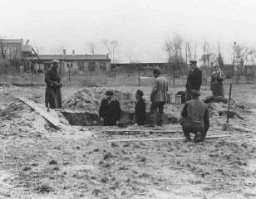
Parade of German police before Adolf Hitler in front of Hotel Deutsches Haus, at a Nazi Party Congress rally. Nuremberg, Germany, September 10, 1937.
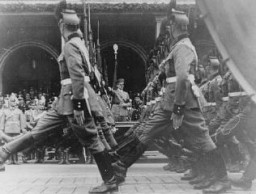
SS and Nazi police prepare for a raid on the Jewish community offices in Vienna. Austria, March 18, 1938.
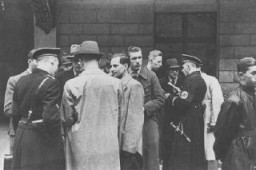
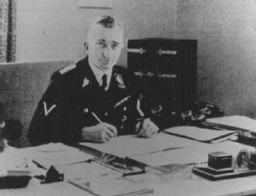
1943 photograph of SS General Ernst Kaltenbrunner, who served as head of the Reich Security Main Office (RSHA) and as chief of Nazi Security Police (Sipo) and the Security Service (SD).
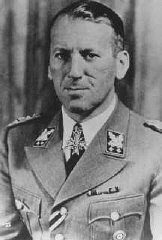
Members of the Hlinka Guard and a squad of ethnic Germans march during a parade in Slovakia, a Nazi satellite state. Date uncertain.
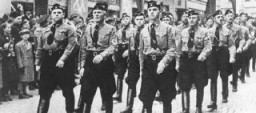
Horia Sima, leader of the Iron Guard and deputy prime minister of the Romanian government in 1940. Bucharest, Romania, 1940. In this image, Horia Sima salutes his supporters during a ceremony commemorating the deaths of Ion Mota and Vasile Marin, Iron Guardsmen who were killed in the Spanish Civil War.
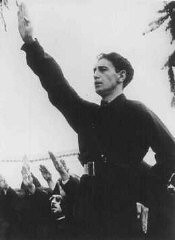
Police force Romanian Jews, survivors of a pogrom in Iasi, to board a train during their expulsion from Iasi to Calarasi. Iasi, Romania, late June 1941.
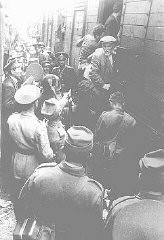
Romanian soldiers supervise the deportation of Jews from Kishinev. Kishinev, Bessarabia, Romania, October 28, 1941.
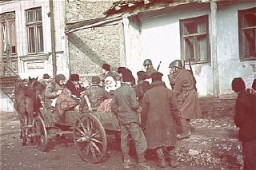
Ustaša (Croatian fascist) soldiers oversee the deportation of a group of civilians from Kozara region to a concentration camp, in the pro-German fascist state of Croatia established following the partition of Yugoslavia. Croatia, between 1941 and 1944.

Children sit and sleep on the floor at Sisak, a Ustasa (Croatian fascist) concentration camp for children. Yugoslavia, during World War II.
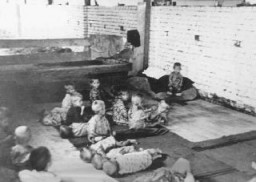
Victims of Ustasa (Croatian fascist) atrocities: the bodies of Jasenovac prisoners floating in the Sava River. Between August 1941 and April 1945.
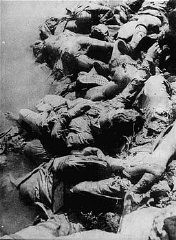
This photograph shows the aftermath of a shooting along the banks of the Danube River in Budapest. Members of the pro-German Arrow Cross party massacred thousands of Jews along the banks of the Danube. Budapest, Hungary, 1944.
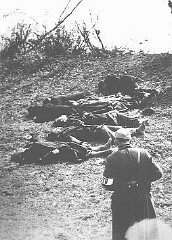
Jews from Bulgarian-occupied Macedonia interned in the "Monopol" tobacco factory, which was used as a transit camp. They were ultimately deported to the Treblinka killing center. Skopje, Macedonia, March 1943.
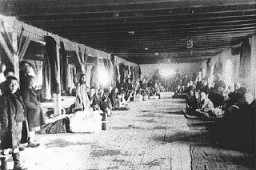
Jews from Bulgarian-occupied Macedonia and Thrace interned in the "Monopol" tobacco factory, which was was used as a transit camp. They were ultimately deported to the Treblinka killing center. Skopje, Macedonia, March 11-31, 1943.
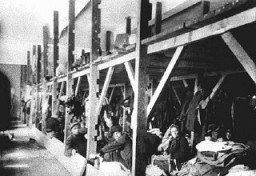
View of the courtyard in the Breendonk fortress prison where prisoners lined up for roll call. Breendonk, Belgium, postwar. This image is taken from a series of snapshots sold on the site after the end of World War II.
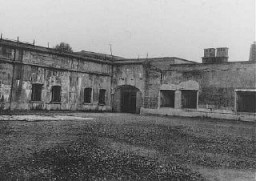
Map of Theresienstadt from an original document (1942-1945) and mounted in an album assembled by a survivor.
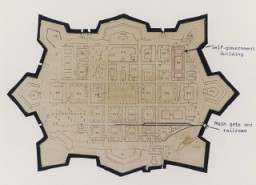
Departure of a train of German Jews being deported to Theresienstadt. Hanau, Germany, May 30, 1942.
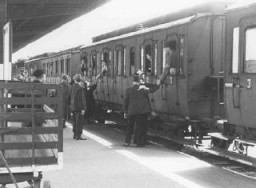
Preparation of food outside a barracks in Theresienstadt. Photograph taken after liberation. Theresienstadt, Czechoslovakia, June–August 1945.
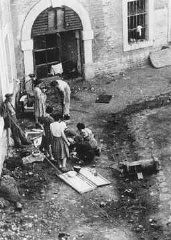
Women prepare food outdoors in the Theresienstadt ghetto. Theresienstadt, Czechoslovakia, between 1941 and 1945.
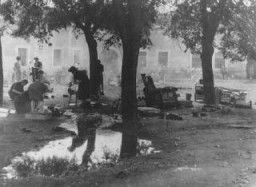
Living quarters in the Theresienstadt ghetto. Theresienstadt, Czechoslovakia, between 1941 and 1945.
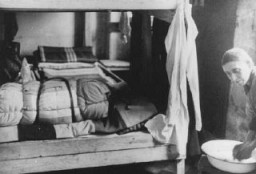
Women prisoners lie on thin mattresses on the floor of a barracks in the women's camp in the Theresienstadt ghetto. Czechoslovakia, between 1941 and 1945.

A transport of Jewish prisoners forced to march through the snow from the Bauschovitz train station to Theresienstadt. Czechoslovakia, 1942.
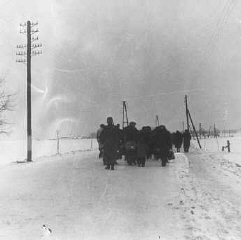
Dutch Jews who have recently arrived in the Theresienstadt ghetto. Czechoslovakia, February 1944.
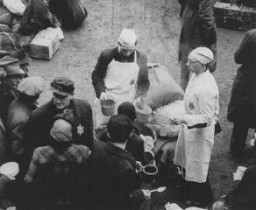
Standing room ticket for an opera performed on April 21, 1945, in the Theresienstadt ghetto.
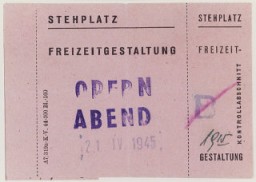
Red triangle patch worn by Czech political prisoner Karel Bruml in Theresienstadt. The letter "T" stands for "Tscheche" (Czech in German).
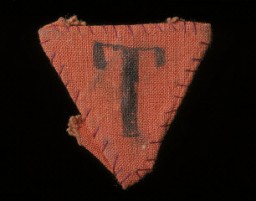
1942 portrait of Ita Guttman with her twin children Rene and Renate. When the twins were very young, the family moved to Prague. In the fall of 1941 the Germans arrested Ita's husband, Herbert. Subsequently, the twins and their mother were deported to Theresienstadt, and from there, to Auschwitz.
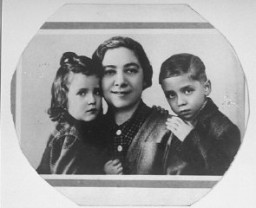
Children's painting showing of Jews celebrating Hannukah. This painting, which was probably drawn by either Michael or Marietta Grunbaum, was made in Theresienstadt and then pasted into a scrapbook by their mother shortly after liberation. Theresienstadt, Czechoslovakia, ca. 1943.
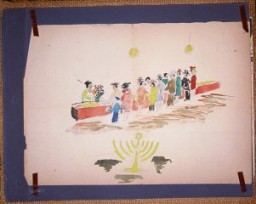
Photograph of the water tower of the Old Town Mills in Prague. After her deportation to the Theresienstadt ghetto in Czechoslovakia, Helene Reik yearned to record what was happening to her. This photograph was sent to Helene, who used it as paper for her diary in Theresienstadt. Helene’s makeshift diary offers wistful memories of her husband and parents who died before the war, loving thoughts of her family who had left Europe in 1939, and a firsthand account of the illness and hospitalization that…
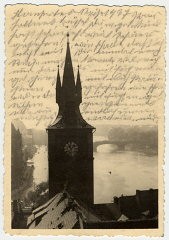
Allied delegates in the Hall of Mirrors at the palace of Versailles witness the German delegation's acceptance of the terms of the Treaty of Versailles. The treaty formally ended World War I. Versailles, France, June 28, 1919.
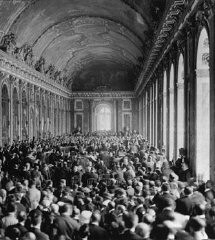
During the remilitarization of the Rhineland, German civilians salute German forces crossing the Rhine River in open violation of the Treaty of Versailles. Mainz, Germany, March 7, 1936.
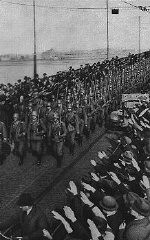
Jewish residents of the Szeged ghetto assemble for deportation. Szeged, Hungary, June 1944.
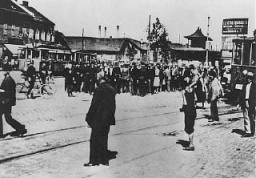
Jewish women, children, and the elderly await deportation at the railroad station in Koszeg, a small town in northwestern Hungary. Koszeg, Hungary, 1944.

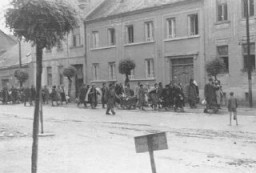
We would like to thank Crown Family Philanthropies, Abe and Ida Cooper Foundation, the Claims Conference, EVZ, and BMF for supporting the ongoing work to create content and resources for the Holocaust Encyclopedia. View the list of donor acknowledgement.